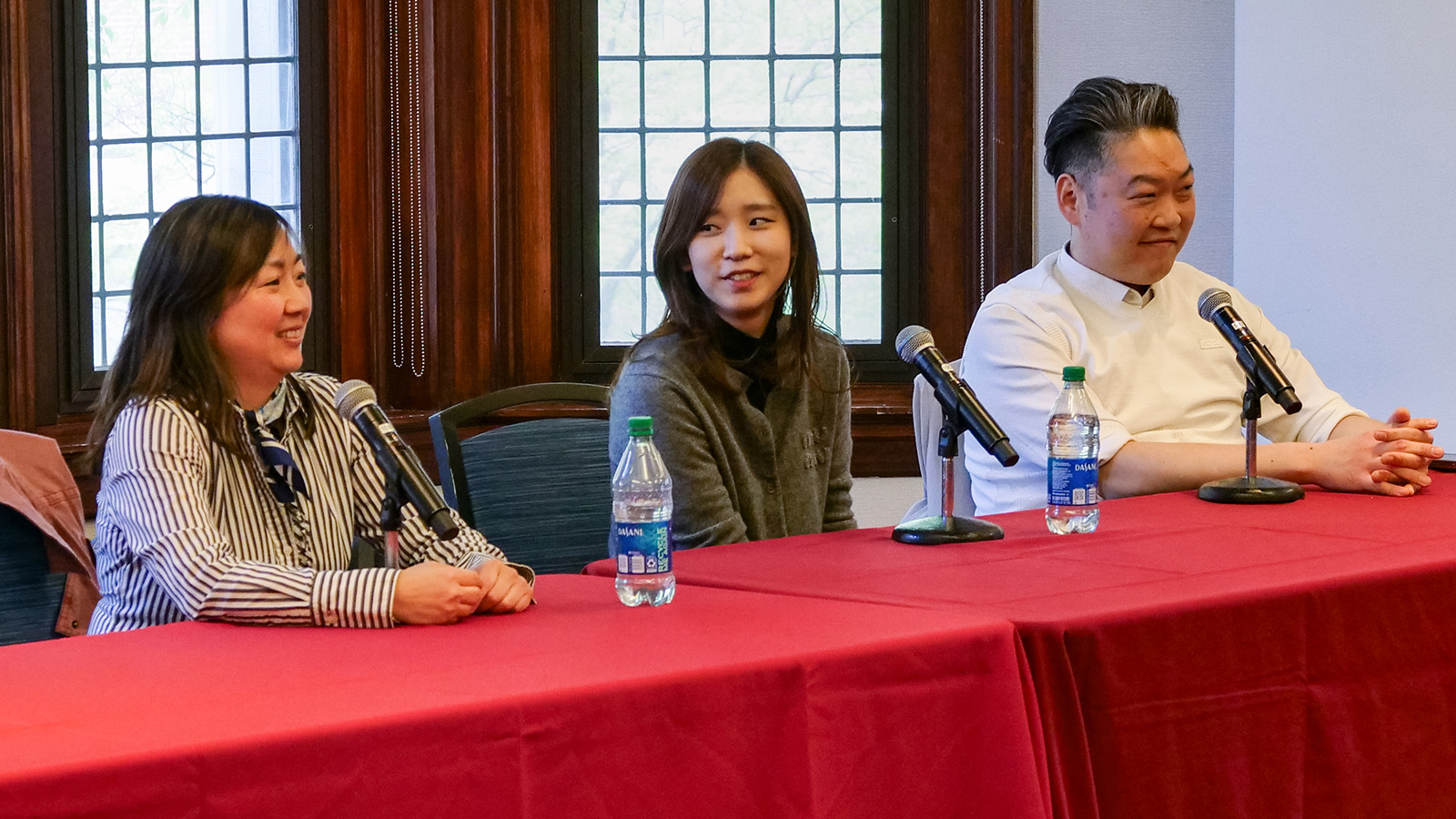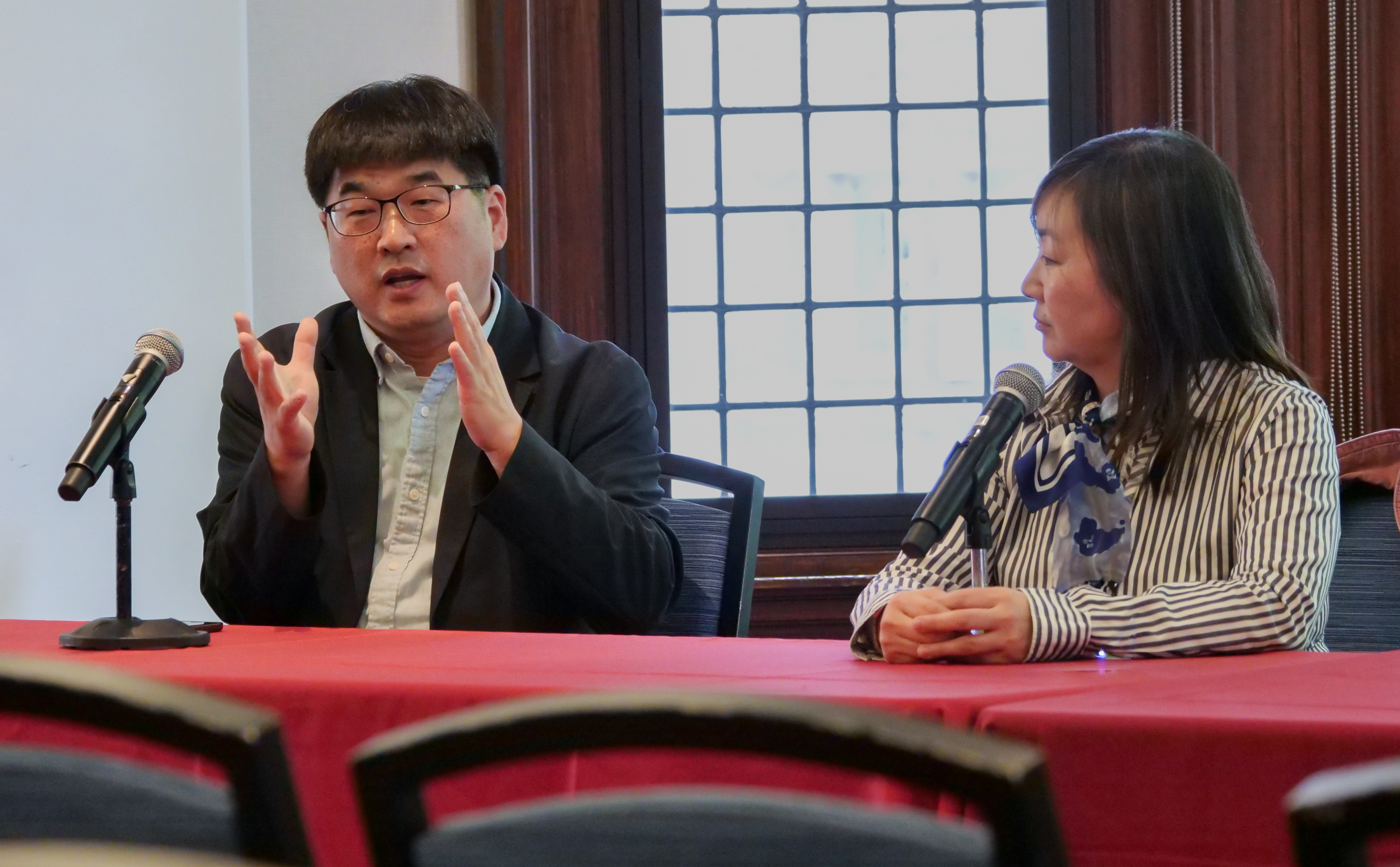Korean-American Musicians Reflect on their Musical Journeys
The event was hosted by the James Joo-Jin Kim Center for Korean Studies in conjunction with the Philadelphia Orchestra, part of the center’s growing focus on community engagement.
What does it take to become a professional classical musician? Each path is different, and during a lively panel discussion moderated by Hyunjoon Park, Korea Foundation Professor of Sociology, three Korean-American musicians talked about their training and education, family influences, professional lives, and experiences as Asian-Americans.
The event, “Conversations with Musicians from the Philadelphia Orchestra,” was jointly sponsored by the James Joo-Jin Kim Center for Korean Studies and the Philadelphia Orchestra.

Philadelphia Orchestra members (from left) violinist Juliette Kang, first associate concertmaster; violinist Christine Lim, associate concertmaster; and violist Marvin Moon discussed their training and education, family influences, professional lives, and experiences as Korean Americans.
Programs like these are part of the Kim Center’s growing focus on community engagement, according to Park, who is the center’s director. “In addition to supporting research and teaching on historical and contemporary Korea and the Korean diaspora, we’re committed to actively engaging with Philadelphia communities to foster a deeper understanding and appreciation of Korean and other Asian-American cultures,” he explained after the event.
The Path to the String Section
The three musicians, Juliette Kang, Christine Lim, and Marvin Moon, all play in the string section of the Philadelphia Orchestra and all three trained at the Curtis Institute of Music, the renowned music conservatory located in the city.
Juliette Kang, the Orchestra’s first associate concertmaster (the second highest-ranking violinist), was born in Edmonton, Canada. She took up violin at age four and came to Philadelphia to study at Curtis at just nine years old. She’s been with the Orchestra for 19 seasons. Music was in her genes—her mother was a pianist—and her violin teacher, who had attended Curtis, encouraged her to apply. “My path to music was determined early on,” she said. “I just had an affinity for it, and I didn’t have a lot of agency. It was very much a family commitment to this one pathway.”
Another Collaboration
This past fall and winter the Kim Center organized another arts-based collaboration, this time with the Philadelphia Museum of Art in connection with its special exhibition The Shape of Time: Korean Art after 1989, which ran from October 21, 2023 to February 11, 2024. The Shape of Time Scholar’s Day, held on January 26, featured a public lecture by Hyunjoon Park, Korea Foundation Professor of Sociology and a conversation with one of the exhibiting artists. The Center also invited K-12 teachers from the Philadelphia region for a two-day workshop on contemporary Korean society and culture followed by a visit to the Museum to view the exhibition. Look for upcoming events this fall at korea.sas.upenn.edu/events.
Violinist Christine Lim, associate concertmaster and the panel’s youngest member, was born in Korea and began violin studies at age three. By seven she’d entered a rigorous music training school there. “I didn’t know what the music meant,” she said. “I just kept going.” Like Kang, she left her home country as a child to study at Curtis.
Philadelphia native Marvin Moon, a violist, landed on music in high school, enrolling at Curtis as a college student. His first love had been baseball, and he’d even been scouted by a few Major League teams. Though his parents didn’t push him in any particular direction, his father told him, “If you play baseball, your career is over by 30.” With lackluster grades in school Moon said “it was either baseball or viola.” He credits his teacher and mentor C.J. Chang, now the Philadelphia Orchestra’s principal violist, and his parents, for paving the way to his chosen career.
Competition Then Collaboration
When Park asked about the competitive aspects of musical training, Lim recalled the grueling competitions she experienced as a child in Korea. Kang and Moon reflected on the contrast between the nerve-wracking auditions that ultimately led them to their current positions and the intensely collaborative ethos of a symphony orchestra.
“Auditioning for a major professional orchestra is extremely harrowing,” Moon said. “It’s a multi-round process where maybe up to 200 people can show up for one position, and the 200 gets whittled down round by round until there are maybe two people left.”
Kang agreed. “Music is, like many other fields, a competitive field,” she said. “And we’re inspired by those around us.” She contrasted it with sports, where judges’ scores and timekeepers show concrete results. “With music it’s more subjective. Did you communicate the most to the audience? Did you bring alive this music or showcase the beauty of it?”
“I Can Offer My Soul”
With their careers solidly on track, Park asked what music means to them.
“Being a professional musician is like living in a dream,” said Moon. “It’s a never-ending journey, personally, musically, to be better all the time. There’s no way we can ever be perfect musicians, and so for me it is a journey of trying to better yourself every day.”
Kang said to her music is a language. “Every performance we have, we’re convening together as performers, interpreters of something created by a composer to be shared with the audience,” she said. “And it’s not a one-way communication. We get feedback and energy from the audience. When we talk about perfecting our music, we’re not just talking about playing in tune and the right notes and timing but aligning our message so that it’s crystal clear for anyone listening what the intent is. And they may have a different experience as a listener—it’s all part of the mystery of delivering art.”
Lim takes satisfaction in knowing that music gives people joy. “I’m doing something where I can offer my soul,” she said.

Hyunjoon Park, Korea Foundation Professor of Sociology and director of the James Joo-Jin Kim Program in Korean Studies, moderated the event.
Feeling at Home in the Orchestra
Park noted the large number of Asian-Americans in the Philadelphia Orchestra, an observation that Kang, Lim, and Moon confirmed. “In our orchestra we have plenty of Asian-Americans, and we’re all in with strings,” said Kang. “It’s an interesting data point.”
Moon said he feels at home in the Orchestra, and speculated that the prevalence of string musicians reflects the influence of trailblazers like a famous South Korean violinist in the 1960s. “The generation after that—all the parents wanted their kids to be the next Kyung-Wha Chung,” Moon said. “Fast-forward a couple of generations and everybody wanted their kids to be Sarah Chang [a Korean-American violinist]. It’s just my own theory, but it’s interesting to look at the history.”
Park closed the discussion with a light-hearted question: “If you could go back to your childhood and choose another instrument, what would it be?”
Kang and Lim both chose the oboe, but for Moon it’s percussion—“just to bang the hell out of something.” He said he’d love to play an instrument called the hammer in Mahler’s Sixth Symphony. “It’s basically just an enormous wooden box and a mallet that is probably six feet tall, and you just sling it and hit the top of the box.”


